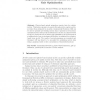Free Online Productivity Tools
i2Speak
i2Symbol
i2OCR
iTex2Img
iWeb2Print
iWeb2Shot
i2Type
iPdf2Split
iPdf2Merge
i2Bopomofo
i2Arabic
i2Style
i2Image
i2PDF
iLatex2Rtf
Sci2ools
101
Voted
EUROGP
2009
Springer
2009
Springer
Exploring Grammatical Evolution for Horse Gait Optimisation
Physics-based animal animations require data for realistic motion. This data is expensive to acquire through motion capture and inaccurate when estimated by an artist. Grammatical Evolution (GE) can be used to optimise pre-existing motion data or generate novel motions. Optimised motion data produces sustained locomotion in a physics-based model. To explore the use of GE for gait optimisation, the motion data of a walking horse, from a veterinary publication, is optimised for a physicsbased horse model. The results of several grammars are presented and discussed. GE was found to be successful for optimising motion data using a grammar based on the concatenation of sinusoidal functions. Key words: Grammatical Evolution, physics-based animation, gait optimisation, quadrupedal locomotion, Fourier analysis
| Added | 24 Jul 2010 |
| Updated | 24 Jul 2010 |
| Type | Conference |
| Year | 2009 |
| Where | EUROGP |
| Authors | James E. Murphy, Michael O'Neill, Hamish Carr |
Comments (0)

